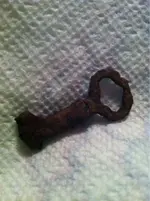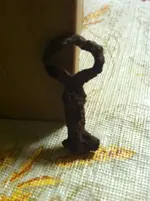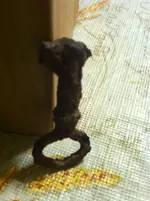Treasurehunter101, as other folks have mentioned, we need exact measurement of your key to identify it with certainty. meanwhile, I'll answer your questions, and add some info. A "clock key" is for winding the clock. Until the mid-1900s, many "table clocks" were wound with a key. My grandmother owned one which was made in the 1930s. You key is one version of "Skeleton keys." They have prongs on one end of a metal shaft, with a ring on the other end. They were used for all kinds of locks, from door-locks to padlocks to clocks, etc. (and even clock-winding). They've been in existence for MANY centuries, with very little change in their shape, so they can very difficult to time-date. I should mention, some are still being manufactured today, as replacements for lost antique-lock keys. Your lock is short-bodied, so it fit a lock which wasn't very thick, such as a padlock or trunk-lock or cabinet-lock. Also, yours has a thick shaft instead of a thin one. That indicates (but doesn't necessarily "prove") it was for a padlock, which sometimes required a lot of force to unlock, so the key tended to be "sturdier." Door locks usually had a thinner and longer shaft.







